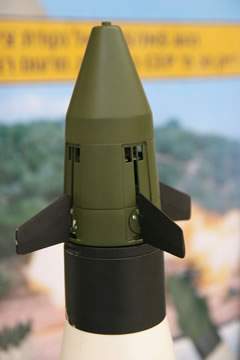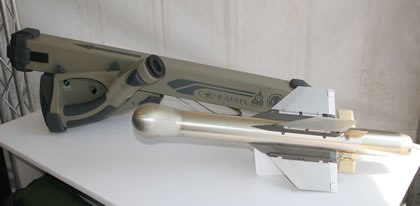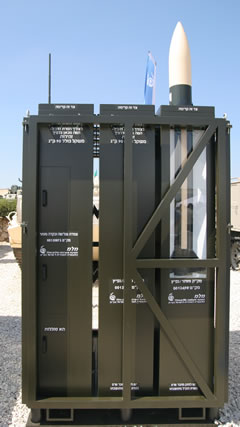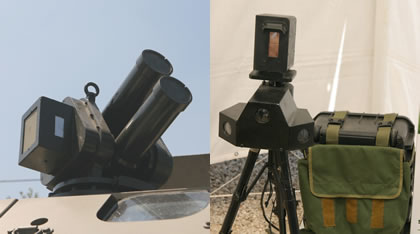New Israeli hardware was unveiled today at the Latrun 3rd annual conference discussing maneuver in complex terrain. Many of the new systems were unveiled by the Ground Forces Command’s (GFC) weapons development department, responsible for the maturization of new weapon systems, command for the armor, infantry, combat engineering and artillery corps. Other programs displayed here are sponsored or supported by the Israel Ministry of Defense Directorate Research & Development (DDR&D) were displayed by four industries that supported the event, including IAI, Rafael, IMI and Azimuth.
Improved Precision for Artillery Projectile

The GFC unveiled an add-on improvement designed for conventional artillery projectiles developed by IAI, improving the accuracy, effectiveness of artillery fire while reducing the risk to friendly forces and minimizing collateral damage resulting from the use of artillery fire in dense and populated areas. The system further improves over the current Trajectory Correction System (TCS) developed by IMI and fielded with the IDF multiple launch rocket systems (MLRS) units and introducing trajectory correction and improved statistical fire accuracy with tube artillery. It employs a GPS receiver and guidance system performing trajectory correction during flight, achieving an average circular error point (CEP) of 20 meters, regardless of the range the projectile is fired at. While still employed as a statistical fire for effect, artillery can be used much more economically, spending significantly less ammunition to achieve the required effect, resulting in reduced logistics, transportation and risk of error. It also means that the required effect can be reached within minutes, rather than over much longer time. When coupled with the new Multi-Mode Radar, developed by IAI’s Elta Systems and soon to be fielded by the Israeli Artillery, the new trajectory corrected guided projectile will further improve the ability of the IDF artillery to address rapid response, precision fire of fire sources soon after these are being detected by the MMR.
Mini-Spike Anti-Personnel Guided Weapon
DDR&D provided a glimpse into some of the new and exciting programs currently underway with participating industries. Among these were the mini-Spike missile system, the smallest member of Rafael’s electro-optically guided missiles. Mini-Spike is the first implementation of an anti-personnel precision attack missile, designed for operation at the company and platoon level. This man-portable missile system weighs about 12 kg, and comprises of a command and launch unit facilitating target acquisition and wireless control for the missile, weighing 4 kg and missiles stored in a canister-launcher, weighing 4 kg each. Typically a soldier will carry the CLU and two missiles with other members of the unit carrying spare missiles. The missile can be fired at targets at ranges of 1,200 meters and can be set to approach the target in a low, medium or high angle of attack, enabling effective engagement of concealed targets. The CLU can be used stand-alone for observation and target acquisition. It features a number of useful operating modes, including video recording and playback.

Remotely Operated, Organic Precision Attack Missile

IAI has unveiled at the event a new and unique operational concept providing dismounted and maneuvering forces an organic, precision attack capability utilizing simple ‘dial a strike’ concept, employing the new vertically launched, supersonic guided missile called ‘Jumper’. The missile’s length is 180 cm and its diameter is 15 cm. Each launch unit weighs about 1.5 tons can be deployed by air, or land and operate in an unattended mode, without requiring support or presence of operators. The launch system covers a radius of 50 kilometers and uses vertical launch to set the missile on course at any direction, without pre-launch slewing or elevation. The launch unit can be loaded with several types of missiles stored in sealed container-launchers weighing about 90 kg each, carrying pre-configured with anti-personnel, anti-structure or penetrating warheads. The missile is propelled by a two-phase rocket motor with low signature and the supersonic speed means that its acoustic signature is also minimal. The missile is stored in sealed containers, each launch unit packs eight missiles and a command control and communications unit. The missiles are using highly accurate GPS/INS guidance, driving four steering surfaces at the aft section. Enhanced GPS/INS will derive accuracy levels comparable to other precision guided weapons. In the basic configuration the missile is designed to be effective against stationary targets designed by geographical coordinate, and is unaffected by visibility and weather conditions. An optional laser guidance enhancement will enable the weapon to hit at even higher precision, enable limited ‘man in the loop’ capability and address moving targets. According to IAI sources, compared to costly electro-optical guidance systems, the entire GPS/INS guidance system can be produced at significantly lower costs, making the new missile affordable for employment at lower formations, such as the platoon level. IAI is also addressing similar (and complementary) capability by employing network-centric laser-guided weapons capability. According to IAI officials, the two trends are expected to merge in the future to address evolving market opportunities.
Shock Absorber – Man-Portable Active Protection System
IMI’s Shock Absorber was developed to protect dismounted infantry detachments and stationary posts, operating in hostile areas, where they are exposed to guided missile threats. The portable kit utilizes a laser based effector employing electro-optical infra-red directional jammer and electro-optical threat detection elements developed for the larger vehicle based active protection systems (Iron Fist – which has already been selected for the Namer AIFV). The system could also employ other countermeasures as required by operational tactics, techniques and procedures. The current system weighs less than 20 kg and can be carried by a single soldier. The system’s development was initiated under the DDR&D armor and protection department and is currently in development and under evaluation by the IDF.
During the 2006 Lebanon War several IDF infantry units were hit when taking shelter in buildings. The new system could be used to increase the protection of such units, when situated in stationary positions, inside buildings or in open terrain.




















